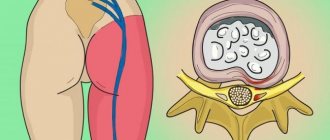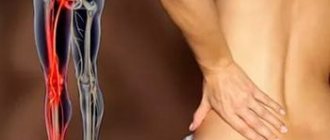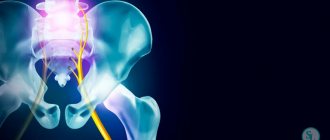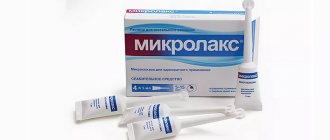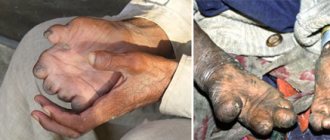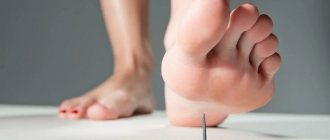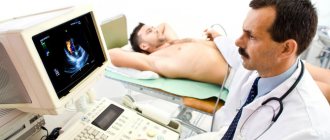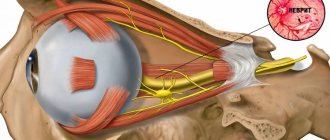The sciatic nerve (sacral plexus) is the largest and thickest nerve in the human body. It is localized in the lumbar spine and passes through the tailbone and lower limbs, reaching the very feet. In an adult, its diameter is 8-12 mm. It is formed by all the roots of the sacral nerve plexus, which is formed by two lumbar and three sacral segments of the spinal cord. This explains the fact that damage to the lower parts of the spinal column often causes pain along the sciatic nerve.
The main functions of the sciatic nerve are to provide sensitive (afferent) and motor (efferent) innervation of the lower extremities. Pinching of the sciatic nerve (sciatica) occurs due to compression of its trunk or root, which is accompanied by severe pain. This is a common occurrence. According to statistics, it can occur in 30% of people who suffer from disorders of the musculoskeletal system.
Causes of pinched sciatic nerve
The nature of the development of pathology and clinical manifestations are very diverse. The most common cause of the disease is compression of nerve fibers in the structure of the spine. Pressure on the nerve roots sometimes leads to their inflammation, accompanied by severe pain. Symptoms manifest themselves differently, depending on the location of the pathological process.
- When one of the roots of the sacral nerve plexuses is compressed by a hernial protrusion, the symptoms manifest as sharp pain, intense when coughing and movement. On the first day, signs of impaired skin sensitivity and muscle weakness appear.
- A root pinched by a dense ligament or bone growths, displacement of discs or narrowing of the spinal canal caused by osteochondrosis causes gradually increasing pain and signs of complete or partial paresthesia. Muscle weakness appears later, and if the process is advanced, muscle atrophy cannot be ruled out.
- Compression of the sciatic nerve by muscles (called tunnel syndrome) can be a consequence of articular pathologies, spinal diseases, injuries, flat feet, and unsuccessful injections in the buttock. It manifests itself as pain in the buttock, burning pain in the sole area, loss of control of the functions of the foot.
- Cut and puncture wounds, injuries and bruises of the sciatic nerve are accompanied by moderate pain. By blocking impulse transmission, they can provoke muscle atrophy, the development of paralysis, dry skin and ulcers on the legs.
Kazieva Aminat Ziyavovna
Neurologist
Rostov State Medical University
Experience since 2012
A kind of trigger for the development of pain can be:
- the influence of unusual physical activity in patients with a tendency to physical inactivity;
- prolonged stay in a forced position at work;
- vibration or power loads;
- body hypothermia;
- infectious pathologies.
The greatest vulnerability to the development of sciatica is observed in middle-aged and elderly patients. Aging of the body leads to degenerative changes in the intervertebral discs. They become coarser, gradually lose moisture, elasticity and height, which leads to compression of the nerve roots and the development of acute pain.
Why does sciatica begin to develop?
Inflammation of this nerve may well be caused by the following factors:
- uncomfortable ambient temperature;
- stressful situations;
- pathologies of the spine, due to which the nerve can become inflamed or pinched;
- spinal injuries;
- diabetes;
- infections;
- lifting too heavy loads;
- lack of physical activity;
- pregnancy;
- drinking alcohol;
- poisoning with any heavy metal;
- gout.
There are many reasons for inflammation of the sciatic nerve
Moreover, sciatica does not necessarily begin because of just one single factor.
There are professions in which the likelihood of getting this pathology is slightly higher than in other jobs. Eg:
- farmer;
- machine operator;
- driver.
It is also exceeded among those whose workplace is not comfortable enough, as well as among smokers.
Also, sciatica can either appear suddenly, for example, due to an injury, or develop gradually, which results from difficult work and/or complications from other pathologies.
Diagnosis for pain in the gluteal region
To identify the causes of pain and make a diagnosis, a physical examination by a neurologist is necessary. As objective methods of diagnostic search, in medical in Rostov-on-Don, high-precision modern equipment is used, which allows you to quickly determine the cause of pathological processes.
1) Using computed tomography, not only the structure of the bones, but also the vertebral discs are examined in detail. A tomograph is indispensable in diagnosing hernial protrusions, tumor formations and damage caused by trauma.
2) Magnetic resonance imaging examination allows us to identify the nature and extent of damage to the sciatic nerve plexuses and the features of the processes occurring in them.
The price for instrumental diagnostics is affordable. It includes the examination itself, its result on disk, and a transcript from the diagnostician.
Sciatica Prevention
According to neurologists, prevention of sciatica can prevent the development of this pathology in four out of five cases.
In the subacute phase, sciatica can be treated with massage.
To prevent this disease, it is necessary to keep the back muscles in good shape. This requires strengthening exercises as well as correct posture. When engaging in sedentary activities, you need to take regular breaks to stretch.
You should not be subjected to injury or overload. Without engaging in professional sports, you cannot prepare your spine for lifting heavy weights. And if the structure of the sciatic nerve is disrupted at least once, there will be frequent pain attacks. So before you lift bags or other heavy objects that are too heavy, you should think carefully about whether it is really necessary.
The lower back should not be exposed to too low temperatures. The sciatic nerve is inflamed by the effect of cold on the lower back, and not on the body in general. And therefore the lower back should be insulated.
It is better to engage in prevention of sciatica and other various pathologies from a young age.
You should control your posture from childhood. When sitting, your back should be kept straight, parallel to the back of the chair. Asymmetrical back positions, as well as carrying heavy weights on one shoulder, are also harmful.
If you even suspect sciatica or a pathology that could be its cause (especially osteochondrosis and tumors), you should immediately be examined by a doctor. Self-medication is contraindicated here.
These tips are good for preventing sciatica, as well as the unbearable pain that occurs because of it.
In what cases is a sciatic nerve block prescribed?
A medication block for sciatic nerve pain is not a form of treatment for sciatica. Indications for the procedure are determined by the need for emergency blockade of severe pain caused by:
Kazieva Aminat Ziyavovna
Neurologist
Rostov State Medical University
Experience since 2012
- pronounced inflammatory process;
- development of local trophic disorders;
- constant aching pain along the affected nerve;
- physical overload of the ligamentous apparatus;
- muscle spasms and myogenic contracture.
The blockade is a highly effective procedure. It is indispensable when it is necessary to quickly eliminate swelling, relieve acute attacks of pain and in cases of severe clinical illness.
Preventive actions
As with any pathology, it is much easier to prevent the occurrence than to treat a pinched sciatic nerve. To avoid the onset of disease, it is important to be careful about your health and follow a number of preventive measures. First of all, you need to strengthen your back muscles. To do this, special physical exercises should be carried out (they are selected by the attending physician).
It is necessary to keep your back straight if possible (do not hunch over while walking, do not sit leaning forward). If a person has a sedentary (office) job, he should take breaks - get up and walk around the room for several minutes. Lifting heavy objects is prohibited and only moderate exercise is allowed. Experts do not recommend exposing the spine to heavy physical activity. Girls with problems in the lumbar spine are not recommended to constantly wear high heels. It is important to keep your lower back warm at all times (to avoid hypothermia).
How is a sciatic nerve block performed?
Drug blockade for neuralgia is an emergency way to relieve pain when injections, tablets and physical therapy methods fail. A blockade of the sciatic nerve for pain is carried out by injecting individually selected drugs into the affected area. Administration of drugs can be perineural or periarticular (into nervous or periarticular tissues).
There are several ways to carry out a blockade for sciatica:
- lying on your stomach (Yasenetsky method);
- lateral access (lying on your back);
- lying on your side according to Moore's method;
- anterior approach - rarely performed. There is a high probability of damage to large vessels.
As an example, we will give a simple blockade technique using the Moore method.
Kazieva Aminat Ziyavovna
Neurologist
Rostov State Medical University
Experience since 2012
- The patient lies on his side, legs bent at the knees. The heel of the diseased limb is pressed tightly against the healthy leg.
- The doctor palpates the tubercle on the hip bone (trochanter) and draws a line from it to the iliac pelvic bone.
- A perpendicular line is drawn from the middle of the line to the coccyx.
- The point of drug administration is the end of the line.
- Within 1 minute, only up to 10% of the drug is administered.
- When the patient feels numbness, the needle is moved deeper without any pain and the remaining medication is injected.
If the blockade is carried out by an experienced doctor and all rules are followed, the procedure is safe. Complications are rare.
- If the medicine enters the vessel during administration, the patient may experience agitation, signs of dizziness and nausea, and tinnitus.
- If a needle damages a vessel, a bruise may remain.
- Failure to comply with the rules of antisepsis and asepsis is manifested by a suppurative process at the injection site.
- In the absence of allergy tests for the drug, allergic reactions may develop.
- Damage to a nerve by a needle causes the development of neurological disorders (impaired motor functions and sensitivity).
- The introduction of a large amount of the drug provokes compression of the nerve fibers, which will lead to even greater pain.
Before choosing a clinic and a doctor, take the time to read reviews from real patients and doctors.
Favorable terms of cooperation
Symptoms and treatment of the sciatic nerve are always the responsibility of specialists. So, as soon as you feel the corresponding symptoms, you should definitely consult a doctor. Our clinic will help you relieve pain and inflammation and restore the joy of active life.
Our specialists have at their disposal all the advanced methods of treating the sciatic nerve - from physiotherapy to massage. Doctors will also prescribe the right combination of medications for you and make sure that the pain does not develop into chronic pain.
Our patients can count on truly attractive prices and comfortable treatment conditions. Give yourself the gift of health and relief from pain and discomfort.
What drugs are used for blockade
To block acute attacks of pain during neuralgia, medications that have an analgesic and anti-inflammatory effect are used in medicine - novocaine blockade, lidocaine blockade and diprospan solution.
Novocaine blockade of the sciatic nerve has:
- bacteriostatic, antiseptic and antiallergic properties;
- pain-relieving effect;
- relieves muscle spasm;
- relieves sudden painful attacks in the area of innervation of nerve branches;
- improves metabolic processes in tissues and nerve fibers;
- normalizes vascular tone and strengthens the walls of blood vessels, which reduces the risk of developing edema.
Lidocaine blockade is not inferior to the properties of novocaine blockade, but provides a longer lasting effect. Stops the flow of pain impulses through nerve tissues, promotes vascular expansion and restoration of blood flow in damaged tissues. Characterized by the absence of local irritation and the rapid effect of muscle relaxation.
Diprospan solution for blockade is a drug for periodic, course administration (up to 4 injections) with an interval of 7 days. Has a rapid analgesic and anti-inflammatory effect.
Sometimes, to enhance the effect, the doctor may prescribe a complex administration of Lidocaine + Diprospan.
Kazieva Aminat Ziyavovna
Neurologist
Rostov State Medical University
Experience since 2012
Main advantages of the procedure
The undeniable advantage of therapeutic blockade compared to other forms of treatment is:
- quick effect - almost instant pain relief;
- rapid reduction of swelling and signs of inflammation in the sacrococcygeal area;
- possibility of reusable use;
- minimum side effects;
- absence of dependence and anaphylactic reactions.
A comment
This work is a description of a new technology for endoscopic decompression of the sciatic nerve with subsequent intrastem mapping of sensory fibers for chronic neurostimulation. The work was written by neurosurgeons - functional specialists in collaboration with neurophysiologists, which generally reflects the modern concept of the development of neurosurgery in terms of protecting and restoring the functions of objects of the central and peripheral nervous system. The ability to perform a complex surgical intervention with simultaneous endoscopic neurolysis, isolation of sensory fibers and installation of an electrode provides an integrated approach to the treatment of this pathology. It is known that 25% of sciatic nerve injuries are iatrogenic and occur mainly as a result of improper injection or as post-transplant complications (Antoniadis et al., 2014). The selection of clinical cases presented by the authors of the article, in all three versions, contains a description of iatrogenic injuries, while in two cases the development of neuropathy was accompanied by severe neuropathic pain syndrome. Intraoperative neurophysiological diagnostics allows you to accurately determine the fibers to be neurostimulated to eliminate neuropathic pain. In our practice of treating iatrogenic and other compression neuropathies, we often use both neurophysiological and ultrasound intraoperative navigation, which in some cases makes it possible to avoid an incision altogether, to implant an electrode by puncture, or, in any case, to reduce the size of the surgical approach, minimizing postoperative scarring process. It would be advisable, despite the small number of cases, to propose some algorithm for the treatment of iatrogenic damage to peripheral nerves, taking into account the prevalence of the pathology, to indicate favorable timing for decompressive operations with neurostimulation (usually 3-4 months) with the response options of the damaged nerve and the specifics of selecting stimulation parameters. Despite this, this work is of unconditional interest not only for functional specialists, but also for neurosurgeons performing operations on peripheral nerves. The technique of access is quite controversial, as it is performed through an incision along the gluteal fold, without the use of special retractors. In my opinion, it would be more convenient to use tubular dilators with endoscope fixation, allowing to limit muscle tissue and fat, which greatly simplifies such interventions, but makes it advisable to use an intraoperative ultrasound device to accurately calculate the access trajectory.
A.O. Guscha (Moscow)
Contraindications
Despite the obvious advantage of drug blockade of the sciatic nerve, it is not available to all patients. This treatment method is contraindicated:
- patients with cardiovascular, renal and hepatic pathologies;
- with increased sensitivity of the body to the components of injectable drugs;
- patients with severe central nervous system damage;
- if there is a history of hemorrhagic syndrome and infectious skin lesions.
For patients with diabetes, stomach ulcers and metabolic disorders, the procedure is performed only in emergency cases, according to the doctor’s opinion.
Inflammation
According to statistical indicators, in most cases, sciatica affects those who are already thirty years old. Every fourth person in the world experiences back pain. And every fifth case of such pain occurs due to inflammation of the sciatic nerve.
This pathology also has a shorter name - sciatica. He also has neuritis, sciatica, neuropathy. All these terms mean the same thing. By the way, this is not the disease itself, but only a syndrome - a signal from the body about diseases in the lower back and sacrum.
Which specialist can help with sciatica?
In the treatment of sciatica, the help of a neurologist is needed. It may also be necessary to consult other doctors:
- vertebrologist;
- neurosurgeon;
- vascular surgeon.
The “main” doctor to contact for sciatica is a neurologist, but he can also refer you to other specialists
During the treatment process, you also need the help of a physiotherapist, exercise therapy and massage specialist. The services of an osteopath may be helpful.
